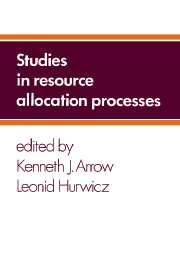Book contents
- Frontmatter
- Contents
- Preface
- Acknowledgments for reprinted articles
- PART I General introduction
- PART II Economies with a single maximand
- PART III Economies with multiple objectives
- 1 Stability of competitive-equilibrium
- 2 Competitive stability under weak gross substitutability
- 3 Stability in oligopoly
- 4 Studies in local stability
- 5 Dynamic shortages
- 6 Foundations of price dynamics
- PART IV General characterizations of allocation processes
- Appendix: An optimality criterion for decision-making under ignorance
- Author index
- Subject index
- Index of examples
6 - Foundations of price dynamics
Published online by Cambridge University Press: 04 April 2011
- Frontmatter
- Contents
- Preface
- Acknowledgments for reprinted articles
- PART I General introduction
- PART II Economies with a single maximand
- PART III Economies with multiple objectives
- 1 Stability of competitive-equilibrium
- 2 Competitive stability under weak gross substitutability
- 3 Stability in oligopoly
- 4 Studies in local stability
- 5 Dynamic shortages
- 6 Foundations of price dynamics
- PART IV General characterizations of allocation processes
- Appendix: An optimality criterion for decision-making under ignorance
- Author index
- Subject index
- Index of examples
Summary
The role of price adjustment equations in economic theory
In this essay, it is argued that there exists a logical gap in the usual formulations of the theory of the perfectly competitive economy, namely, that there is no place for a rational decision with respect to prices as there is with respect to quantities. A suggestion is made for filling this gap. The proposal implies that perfect competition can really prevail only at equilibrium. It is hoped that the line of development proposed will lead to a better understanding of the behavior of the economy in disequilibrium conditions.
In the traditional development of economic theory, the usual starting point is the construction for each individual (firm or household) of a pattern of reactions to events outside it (examples of elements of a reaction pattern: supply and demand curves, propensity to consume, liquidity preference, interindustrial movements of capital and labor in response to differential profit and wage rates). This point of view is explicit in the neoclassicists (Cournot, Jevons, Menger, and successors) and strongly implicit in the classicists (from Smith through Cairnes) in their discussion of the motivations of capitalists, workers, and landlords which lead to establishment of the equilibrium price levels for commodities, labor, and the use of land. The basic logic of Marx's system brings it, I believe, into the same category, although some writers have referred to his theories as being “class” economics rather than “individual” economics.
- Type
- Chapter
- Information
- Studies in Resource Allocation Processes , pp. 380 - 390Publisher: Cambridge University PressPrint publication year: 1977
- 3
- Cited by

